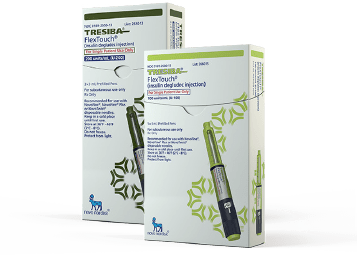Previously, there were two competitors in the market of Basal Insulin treatments, Levemir and Lantus. But this market has since included some newcomers, including that of Tresiba. Basal insulin treatments are used for both patients with type 1 and type 2 diabetes over the age of 18. How does this new kid to the basal gang compare to others on the market?
Let’s take a look:
What is Tresiba?
Tresiba is a once daily injection that comes in FlexTouch insulin pen form. Unlike Lantus, Tresiba works for up to 42 hours, offering you better flexibility with meal planning.
During a clinical study, those with Type 2 diabetes, adults were able to vary their daily dose time and still maintain blood sugar control when compared to Lantus.
Study Determination for Type 2 Patients
This study determined that adults who have type 2 diabetes still were able to vary their dosing schedule with Tresiba by 8 to 40 hours with no complications to their blood sugar control. Taking Tresiba at differing times still provided the same type of control that taking Lantus at the same time each day provided.
NOTE: When taking Tresiba at different dosing times, it’s important to always ensure that there is at least eight hours between doses.
If you are interested in more Type 2 Diabetes look at these articles:
Study Determination for Type 1 Patients
When comparing Tresiba to Lantus for adults with Type 1 diabetes, the study determined that when taking a once daily injection of Tresiba in combination with fast-acting insulin for meal times, Tresiba and Lantus both provided similar results in blood sugar control.
Warnings and Safety Information Concerning Tresiba
Do NOT Share: Because Tresiba comes in the FlexTouch pen format this medication should never be shared between more than one patient, even if you change the needle. Sharing medications in pen format expose patients to the potential risk for the transmission of blood pathogens.
Hypoglycemic Control: Blood sugar levels should be monitored at all times when Tresiba is used. Insulin use can affect your blood sugar control this is why it is vital to make sure you are constantly monitoring your levels to prevent hypoglycemic and hyperglycemic episodes. Hypoglycemia can be potentially life-threatening and should be treated appropriately if it occurs. Make sure you are not making changes or adjustments to your dosage of Tresiba on your own, but instead with your physician.
Allergic Reaction: Severe sometimes life-threatening anaphylaxis can occur when you are using insulin products. If you notice you experience any allergic reactions when starting this product, make sure you contact y our doctor immediately.
Fluid Retention: Heart failure as well as fluid retention can occur, although rarely with the use of thiazolidinedione’s (TZD). Make sure you monitor yourself for any potential symptoms of heart failure, which include:
- Dizziness
- Fatigue
- Loss of Appetite
- Pain in the Chest
- Fast Breathing
- Shortness of Breath
- Dry or Phlegmy Cough
- Water retention
- Bloating
- Heart Palpitations
- Swollen legs or feet
- Weight Gain
If you want to know more here are some informational articles:
The Use of Tresiba in Children with Type 1 or Type 2 Diabetes
Tresiba is approved for usage in children with Type 1 or Type 2 diabetes who are 1 year of age or older. However, pediatric patients who are not yet using at least 5 units of Tresiba for their daily dose of basal insulin cannot use Tresiba.
Make sure you speak with your child’s doctor to find out what their recommendation would be for the use of Tresiba. But typically pediatric patients who start taking Tresiba start at 80% of their current basal use to reduce the risk of hypoglycemic episodes. For children with Type 1 diabetes, doctors recommend starting at ⅓ to ½ of their total daily dose (TDD) of basal insulin.
When compared to other basal insulin pen formats, the Tresiba offers a lower extension of the push button. This makes it much easier to inject with for younger pediatric patients who are able to do their own injections.
Conclusion
When considering switching to Tresiba, it’s important you speak with your doctor first to get their recommendation on if this basal treatment option would be beneficial to you.
Overall, Tresiba seems to be a good choice for those who need greater flexibility in their insulin regimen. If you’ve already made the switch comment below and let us know what you think about this insulin.
TheDiabetesCouncil Article | Reviewed by Dr. Christine Traxler MD on May 20, 2020






